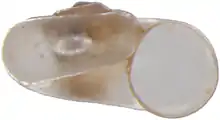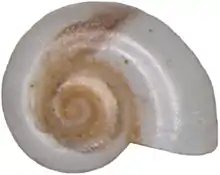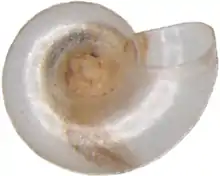Hauffenia sp. nov.
Hauffenia sp. nov. is an as yet undescribed (in 2013)[2] species of freshwater snail that lives underground, an aquatic gastropod mollusk in the family Hydrobiidae. This species is found in Slovakia.
| Hauffenia sp. nov. | |
|---|---|
 | |
| Apertural view of a shell of Hauffenia from Slovakia | |
| Scientific classification | |
| Kingdom: | |
| Phylum: | |
| Class: | |
| (unranked): | |
| Superfamily: | |
| Family: | |
| Genus: | |
| Species: | H. sp. nov. |
| Binomial name | |
| Hauffenia sp. nov. | |
Taxonomy
The genus Hauffenia is taxonomically problematic.[3]
Šteffek et al. (2011)[4] confirmed that the snail from Slovakia appears to belong to the genus Hauffenia, based on the morphology of the penial characters.[4]
However, molecular phylogeny research based on sequences of mitochondrial cytochrome-c oxidase I (COI) genes appears to demonstrate that although these snails belong to the family Hydrobiidae, they are not closely related to the genus Hauffenia.[4]
These snails from Slovakia may actually represent not one species but two genera: Hauffenia and Lobaumia.[4]
Specimens of this species are preserved in private collections.[3]
Distribution
This species is endemic to Slovakia.[5] It lives only in the Slovak Karst, where it was discovered in the 1980s.[5]
The former (subrecent) distribution of this species included also Miličské travertíny travertines near Banská Bystrica.[5]
Description
The shape of the shell is valvatiform. The shell is thin-walled and glossy.[4] The shell has 2–2.5 rapidly but regularly growing whorls.[4] The spire is low or very low.[4] The umbilicus is very wide, with the earlier whorls visible inside.[4] The teleoconch is very finely sculptured with weakly marked growth lines.[4] The protoconch has about 1¼ whorls growing slowly; the border between the proto- and teleoconch is indistinct; the protoconch surface is nodular.[4]
The width of the shell is up to 1.2 mm[5] or up to 1.8 mm.[4] The height of the shell is up to 0.8 mm[5] or up to 0.9 mm.[4]
 Photo of apical view. |
 Photo of umbilical view. |
The animal has no body pigment and no eyes.[4]
The sexes are distinct (females and males occur). Reproductive system: The penis is broad and blunt, has a weakly marked lateral lobe on its left side near the apex, a very small stylet, a penial duct running in a zigzag, and no visible trace of an ejaculatory duct.[4] The female reproductive organs are of Hauffenia-type.[4]
Ecology
This species lives in subterranean waters[5] and in springs.[2] This species is very rare.[4]
References
This article incorporates CC-BY-3.0 text from the reference[4]
- Šteffek J. (1996). "Hauffenia sp. nov.". 2006 IUCN Red List of Threatened Species. Downloaded on 7 August 2007.
- Horsák M., Juřičková L. & Picka J. (2013). Měkkýši České a Slovenské republiky. Molluscs of the Czech and Slovak Republics. Kabourek, Zlín, 264 pp. p. 44-45 (in Czech and English).
- Čejka T., Dvořák L., Horsák M. & Šteffek J. (2007). "Checklist of molluscs (Mollusca) in the Slovak Republic". Folia Malacologica 15(2): 49-58.
- Šteffek J., Falniowski A., Szarowska M. & Grego J. (2011)."“Hauffenia” Pollonera, 1898 (Caenogastropoda: Hydrobiidae) in Slovakia: a preliminary report". Folia Malacologica 19(1): 1-7. PDF.
- (in Czech) Horsák M., Juřičková L., Beran L., Čejka T. & Dvořák L. (2010). "Komentovaný seznam měkkýšů zjištěných ve volné přírodě České a Slovenské republiky. [Annotated list of mollusc species recorded outdoors in the Czech and Slovak Republics]". Malacologica Bohemoslovaca, Suppl. 1: 1-37. PDF.
External links
- "Hauffenia sp. 1 AF-2011". National Center for Biotechnology Information (NCBI).
- "Hauffenia sp. 2 AF-2011". National Center for Biotechnology Information (NCBI).
- "Hauffenia sp. 'Patrocnica spring'". National Center for Biotechnology Information (NCBI).
- (in Slovak) Ložek V. (1994). "Mäkkýše (Mollusca). In: Slovenský kras (Chránená krajinná oblasť – biosférická rezervácia), Rozložník M. & Karasová E. (eds), Osveta, Martin. pp. 138–143.
- (in Slovak) Ložek V. & Galvánek J. (1987). "Geologická poloha a biostratigrafický rozbor chráneného prírodného výtvoru Mičinské travertíny. Ochrana prírody 8: 221–240.
